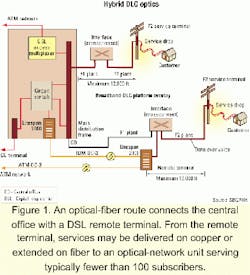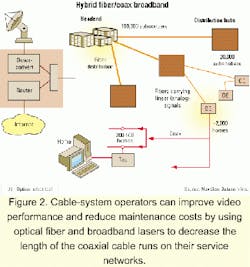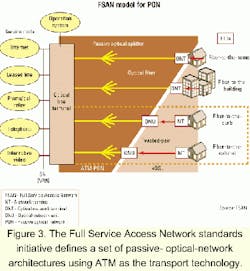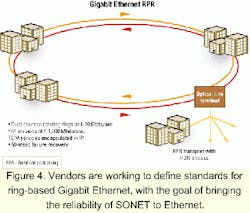Access networks: Looking back suggests what's ahead
Broadband access is finally being rolled out, but uncertainty about the architecture and pace of change remains.
DAN HANSON, RHK Inc.For most end users, the state of access networks has not changed significantly in decades. Despite the heavy spending on network upgrades in recent years, the bulk of major U.S. carriers' investment has gone into increasing capacity in their core national networks to accommodate the growth of data and Internet traffic. The result has been a significant decrease in the cost of long-haul traffic and long-distance voice and a number of competitors vying for voice and data traffic.
There are, however, some good reasons to think that things in the access arena may be changing. After years of tenuous starts, the large-scale rollout of broadband services to residences has begun in earnest. The two leading services, cable modem and xDSL, are now in use by about 8.3 million North American subscribers. Significant numbers of users are also coming online in Korea, Japan, Germany, the United Kingdom, and other countries.
The uncertainty in the access-network evolution remains the exact direction and pace of change. A little history helps to illustrate this point. The 1990s began with huge interest by the regional Bell operating companies (RBOCs), cable multiple system operators, and other service providers in broadband access for residences and small business. The primary service motivating this interest was combining voice and video-known generally as Video Dial Tone. Systems to address this interest were developed by a number of vendors, including passive-optical-network (PON) systems from Raynet (later part of Ericsson Inc.) and ADC as well as digital-loop-carrier (DLC)-based fiber-to-the-curb (FTTC) systems from Reliance (now part of Marconi), DSC (now part of Alcatel USA), AT&T (now Lucent Technologies), Nortel Networks, and others. At this time, asymmetric DSL was a very early-stage technology.
By the mid-1990s, a large number of trials had been performed on all these products in an effort to evaluate both the technology and possible service offerings. While the trials were generally considered successful, none resulted in large-scale deployments. The RBOCs' attention shifted from all-optical to hybrid fiber/coaxial (HFC) systems. Another round of trials followed; that still did not result in significant deployments of HFC systems by the RBOCs.In the meantime, the Internet was becoming an important factor driving the use of home computers. The limits of dial-up connections were clear to everyone who logged on. By the last years of the decade, it was data, not video, that really motivated broadband deployment. Cable systems operators and telephone companies were now in a race to roll out a high-speed data service, using their existing networks-not an entirely new architecture. Cable operators chose cable modems, while RBOCs selected xDSL as the technology to deliver these services.
So, what's the point of the history lesson? Simply this: It has taken a full 10 years for the industry to finally select a technology and begin deployments on a broad scale. During that time, everything has changed: the technologies, suppliers, and motivations. We should expect that future evolutions in the network will be just as difficult to forecast as those in the past. The continued evolution of access networks is a virtual certainty, with several optical and non-optical architectures recently emerging (or reemerging) to provide increased bandwidth to small-business and residential subscribers. Certainly, optical technologies will play an important role in the future of both residential and business access.The market for broadband access services is easily divisible into two unique segments: business and residential. The residential market for broadband presents a number of challenges to the service provider. Building new high-speed networks to large residential communities is extremely capital-intensive. To make matters more difficult, the appetite for bandwidth among consumers appears to be quite large, while the willingness to pay seems quite modest. This combination of factors makes it very difficult for any residential network build-out to reach profitability. Nonetheless, the market potential for residential services is extremely large and significant work is going on in this area.
Millions of homes and businesses in North America already receive telephone or video services via fiber, using either DLC for telephone or HFC for cable TV. However, neither of these systems extends the reach of the fiber close enough to the subscriber to overcome the limitations of the "last mile" technology. While both DLC and HFC perform very well at their basic mission, both systems have needed significant upgrades and improvements to deliver broadband data services. In the past several years, two new all-optical technologies have emerged as alternatives for optical access: PON and point-to-point Gigabit Ethernet. Both techniques offer potential advantages to service providers and end users.
FTTC technically refers to any system that brings fiber within a few hundred feet of the subscriber. But the term usually refers to the practice of extending fiber from a DLC remote terminal closer to the subscriber. In a typical installation, an optical fiber route connects the central office with a remote terminal that is placed to serve from a few hundred to 2,000 subscribers (see Figure 1). From the remote terminal, services may be delivered on copper, or extended on fiber to an optical-network unit (ONU) serving a very small area, typically fewer than 100 subscribers. Because such FTTC systems evolved from DLC, they are very efficient for delivering voice and wideband data. DLC is widely deployed by local-exchange carriers in North America, serving approximately 30% of access lines. That gives the FTTC systems a natural market base on which to build. However, DLC was originally designed as a narrowband service delivery system, primarily for voice. Consequently, many existing DLC systems are not easily upgraded to provide the additional bandwidth required for wideband or broadband services.HFC is a derivation of the all-coaxial cable TV networks that started appearing in North America about 50 years ago. Originally, these systems were strictly unidirectional video distribution networks. Because the coaxial cable was prone to losses and the required amplifiers added noise and distortion, the systems were far from perfect. Cable-system operators realized that they could improve the video performance of their networks, thereby reducing their maintenance costs, by using optical fiber and broadband lasers to decrease the length of the coaxial cable runs. Depending on the operator's design choices, a fiber node serves from 200 to about 2,000 subscribers. During the 1990s, many cable systems were further upgraded to provide bidirectional transmission, and cable modems began to appear to allow subscribers to send data upstream over the HFC network (see Figure 2).
Today, about 70% of all the cable plant in North America is two-way-capable, and about 60% of residences are cable TV subscribers. Most cable-system operators would like to be able to offer voice in addition to data service. However, the basic design of HFC limits the bandwidth that can be directed from subscribers into the network. Consequently, the technical challenges of providing data or voice service on this type of physical network are not trivial.PON was originally developed in the late 1980s. The key distinguishing feature of PON is the elimination of electronics from the last miles of the access network. Instead of the remote terminal used in a DLC-type system, passive optical splitting is used to derive the individual fibers for end users. Such systems have the advantages of a relatively low cost for the distribution portion of the network and savings in the power, real estate, and maintenance costs associated with a remote terminal.
While the passive splitting aspect of PON technology provides genuine cost advantages, it also presents some difficult technical challenges. Because it is a multiple-access system, with variable ranges on all the branches, timing on PON systems must be very precise to ensure that end-user traffic is not lost or misdirected. Also, capacity planning for PONs must be considered carefully when designing the physical network.
Second-generation PON systems have been under development for several years; many startup suppliers are planning to participate in this market, along with several established access players. Major carriers, including several U.S. incumbent local-exchange carriers; European postal, telegraph, and telephone providers; and Asian service providers, have been supporting this development activity through participation in the Full Service Access Network (FSAN) initiative (http://www.fsanet.net/). FSAN defines a set of PON architectures using ATM as the transport technology (see Figure 3). It is proposing PON as ITU draft standard G.983.
Recent developments in the PON market have been significant. In May 2001, SBC announced its plan to deploy a PON system for business and possible residential use as part of Project Pronto, its major access initiative. Other carriers are also known to be deploying or considering PON as an access alternative.
Even though estimates of the rate of increase vary, the increasing importance of IP-based traffic is undeniable. The primary network type for transporting IP packets within an enterprise is Ethernet. It comes as no surprise, therefore, that Ethernet would begin to find a place in public networks. The cost and manageability of Ethernet networks have been improving for years; now, a number of service providers and vendors are hoping to take advantage of Ethernet in metro-area and wide-area networks. The availability of dark fiber networks has allowed several new service providers such as Telseon, Yipes, and Cogent to begin offering native Ethernet-based services to businesses at very attractive prices. In most cases, the network chosen for Gigabit Ethernet services is a simple point-to-point fiber or a wavelength on a fiber, with either a switched mesh or a metro-area ring to connect multiple sites to a long-haul carrier's point of presence. Deployment of native Ethernet services is still in the very early stages. However, many major carriers have now made service announcements; RHK expects this type of service to be a significant factor in networks in coming years.Traditional Ethernet has not been used in public networks until very recently; not surprisingly, the requirements of most service providers for redundancy, reliability, latency, and equipment packaging have not been addressed by previous generations of equipment. A number of technical innovations are on the horizon that will address some of these difficulties. The Resilient Packet Ring (RPR) Consortium includes a number of vendors working to define standards for ring-based Ethernet, with the goal of bringing to Ethernet the reliability but not the complexity of SONET (see Figure 4). Also under consideration is the possible combination of Ethernet-based PON systems for access with RPR, Gigabit Ethernet, or 10-Gigabit Ethernet systems for transport. The Table summarizes the various access technologies mentioned.
A number of industry suppliers have made major investments in developing products based on one or a combination of these basic architectures. Even during the recent deflation of market values for telecommunications suppliers, significant startup activity has continued, with new entrants to the supplier market for access still appearing at a brisk pace. The level of success achieved by any of these firms will, of course, depend heavily on many factors, only a few having to do with the objective merits of the technology. Carrier regulation, competition among service providers, end-user demand, overall economic conditions, and the ability of suppliers to create and maintain customer relationships all will play heavily into the ultimate direction of the telecom industry for access technology.
Dan Hanson is director of access-network systems at telecommunications market researcher RHK Inc. (South San Francisco, CA).






